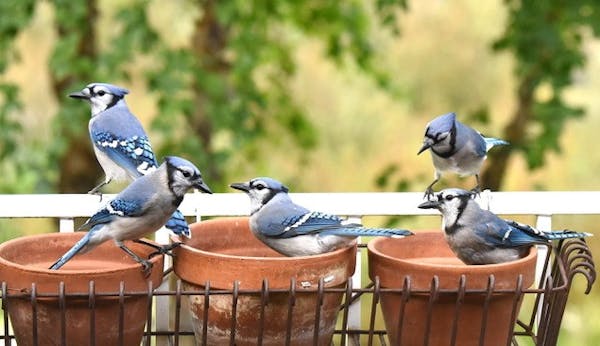Q: With winter not far away, I'm wondering if many or any birds store food for the winter?
A: Some of the birds that live among us all winter store food in fall and winter to tide themselves over during the cold months. This is called stockpiling, or caching, and two of its biggest proponents are the tiny black-capped chickadee and the much-larger blue jay. Chickadees will stuff seeds into bark crevices and under fallen leaves, while jays tap acorns into the soil or tuck them under leaf piles. This behavior has been extensively studied by researchers who say that chickadees remember exactly where they've hidden each and every food item. Other birds that cache food for the lean times include the red-headed woodpecker, white-breasted nuthatch and the American crow. Even with food stuffed around the neighborhood by some birds, it's a good idea to keep feeders filled with high-energy seeds and suet in winter.
Eagles as scavengers
Q: Do bald eagles make a contribution to cleaning up dead animals through their scavenging? Do we know what percentage of their diet, especially in winter, is scavenged?
A: These are good questions, and for some answers I turned to Scott Mehus, education director at the National Eagle Center in Wabasha, Minn.:
"I'd say that 75% or more of the diet of bald eagles along the Mississippi River in winter comes from scavenging — even with open water, most of the fish that the eagles feed on are dead fish floating in the water." He added that they're opportunistic predators and also feed on roadkill and other sources of carrion, including hunters' gut piles. Such scavenging can lead to trouble in terms of collisions with vehicles and poisoning from lead ammunition in the gut piles. During nesting season, Mehus says, the picture changes, with the majority of bald eagles' diet coming from live prey, such as fish, ducks, snakes, muskrats and rabbits.
Time to clean?
Q: We have two bluebird houses at our cabin and in both cases there are eggs still in the nests inside. Should we clean these out now?
A: Yes, it's time to clean out those nest boxes. The bluebirds abandoned their nests for some reason, and now have migrated out of the state. Let's hope they're more successful next year.
Who's the culprit?
Q: Something was drinking up all the hummingbird nectar overnight this summer, and I read on the internet that bats sometimes do this. What do you think?
A: I think it's highly unlikely in Minnesota, but possible in Tucson — all of the bat species in our state are insect hunters and wouldn't find sugar water appealing. In the desert Southwest, however, two bat species feed on cactus blooms and agave flowers and are important pollinators for those two plants. They're known to drain hummingbird feeders, too. Here in Minnesota, though, the finger usually points at raccoons.
Too many eggs
Q: I was talking to a bluebird monitor at a nature center, and he mentioned that he found 12 blue eggs in one bluebird nest box this year. Isn't that unusual?
A: It is not at all common to find such a high number of bluebird eggs in one nest box, since bluebirds generally care for four to six eggs. I talked to that same bluebird volunteer and he surmised that a female laid six eggs, then something happened, either she abandoned the eggs and another female took over and laid her own six eggs, or the original female didn't trust that the first six eggs were viable, so laid six more. It would be interesting to know how many, if any, young birds fledged from this situation.
What drives migration
Q: Please settle an argument: I say birds migrate away in the fall because the days are shorter, but my neighbor says it's because of the cold. Which of us wins?
A: You're both somewhat right but neither has the whole story. Yes, there's less daylight in autumn, meaning less time to forage for food, and cold weather means birds need more calories to survive. But the birds that traveled north in the spring rely on food sources — insects and fruits — that aren't available here in winter. When the insects begin to disappear and the wild fruit is almost gone, migratory begin to head south. Most birds could survive cold weather if they could find enough calories to stoke their inner furnaces, but cold and scarce food supplies is a fatal combination. The birds that are adept at finding hidden insects, like woodpeckers and chickadees, or those that rely on seeds, like finches and cardinals, are able to survive our winters, as are the food stockpilers, like blue jays.
St. Paul resident Val Cunningham, who volunteers with the St. Paul Audubon Society and writes about nature for local, regional and national newspapers and magazines, can be reached at valwrites@comcast.net.
